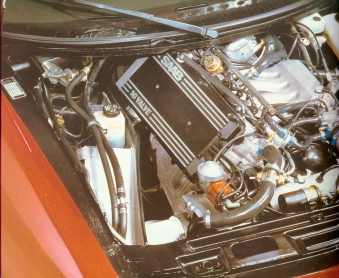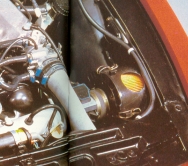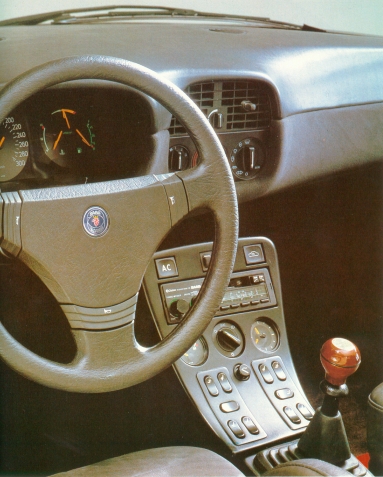

I first saw the EV-1 in the online Saab Museum a few years ago. Although interesting to look at, the fact that it was assembled from off-the-shelf Saab components was its most intriguing aspect. I spent quite some time looking for more information on the car, but found very little.
Then, one day I was flipping through a friend's collection of sports car books and ran into a very large article on Saab's "supercar," the EV-1! I took the liberty of scanning a couple pictures and grabbing some of the important facts from the book, and here they are!
| Here we have a look at one half of the engine compartment. Notice the stock-looking 2.0l Saab 16v engine sitting quietly in there. It's hard to tell if anything substantial has been changed - the only visual cue is the odd scoop-looking thing where the battery would normally go. Other than that, you might never know you weren't looking a stock 900T... |  |
 |
Here's the other side of the engine compartment. If you'll ignore the crease from the center of the book, you'll notice a very interesting assembly where the intake/intercooler normally would be. This seems to be a more free-flow version of the standard airbox and nothing more, but who knows? Also observe the pipe running from the throttle body to the [presumably] front-mount intercooler, like a 9000 has.. |
| Although it really doesn't have anything to do with the performance of the car, I thought I would include this somewhat interesting shot from the interior. Notice all the equipment taken right from a run-of-the-mill 9000, including the dashboard vents and the instrument cluster, even the clock. The air-flow control (temp & direction) as well as most of the push-buttons are from a 900. Notice the wooden shift knob and the side bolstering (barely visible) of the seats. It also looks like those are controls for power seats on either side of the cigarette lighter. For a car in 1985, much of the interior design and ergonomics could have come from a brand new model! I do wish they had eventually used the nice slope of the center console in 900s. |  |
Here is some relevant text from the five page article on the EV-1:
"The lighter and more aerodynamic bodyshell of the EV-1 would in itself have contributed to a superior performance envelope for the Saab 900 Turbo 16-valve, but Saab further modified the EV-1's engine, with development work once again having possible consequences for future standard production cars. Engine output has been boosted by increasing the sizes of the intake and exhaust systems, thus allowing higher rates of gas flow. Bosch LH-Jetronic fuel injection is used in combination with an intercooled Garrett T1098 turbocharger and Saab's patented Automatic Performance Control (APC) system which allows the engine to adapt to varying grades of fuel. To enable boost pressure to be raised to 15.6 psi, the compression ratio was reduced from 9:1 to 7.2:1 and the engine incorporates forged pistons and reinforced connecting rods. The result of this is a dramatic lift in power from the 185bhp of the standard production 16-valve engine to 285bhp at 6,500rpm, but perhaps more impressive is the maximum torque of 246 lb ft at a moderate 3,500rpm. Despite not having a dramatically low Cd as part of its design brief, the EV-1 easily achieves a Cd of 0.32 which, when multiplied by it's small frontal area of 2 square yards (1.72m2), gives the low CdA value of 0.55. A top speed of 186 miles per hour can thus be achieved and through the gears the EV-1 passes 60mph in 5.4 seconds, 120mph in 18.5 seconds, and the standing quarter mile in 13.9 seconds."